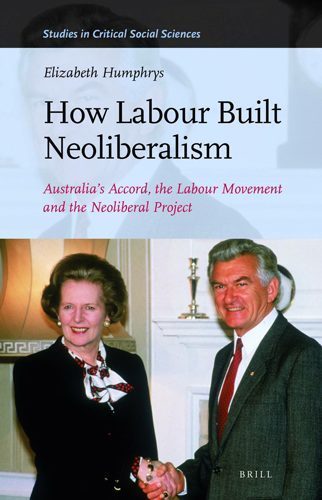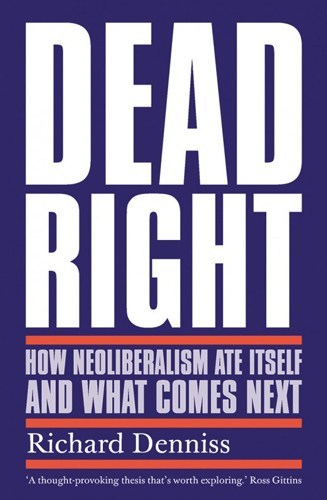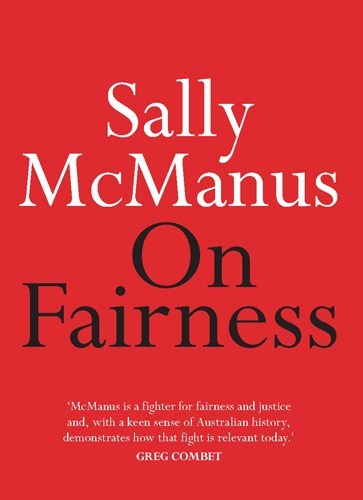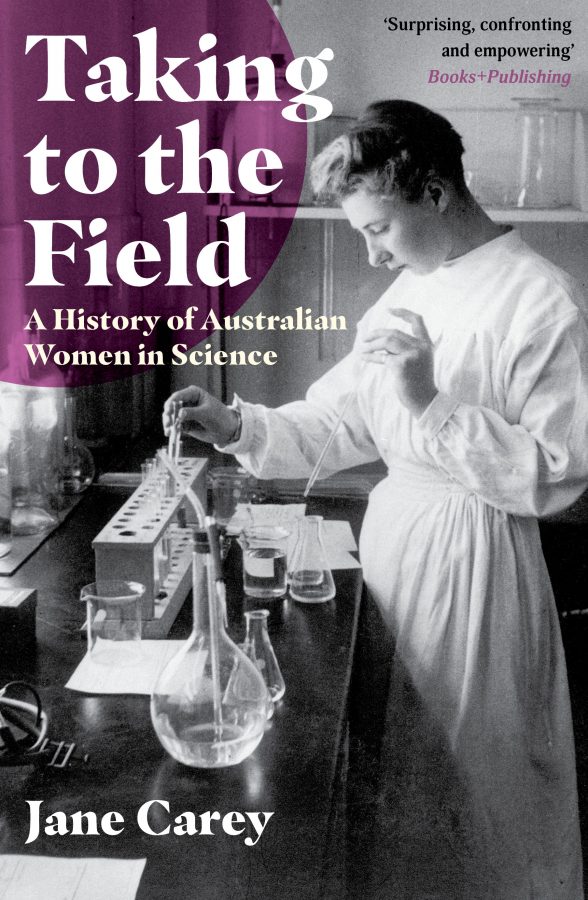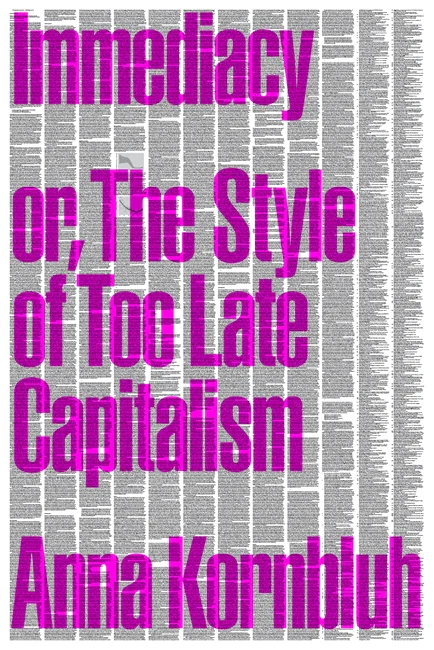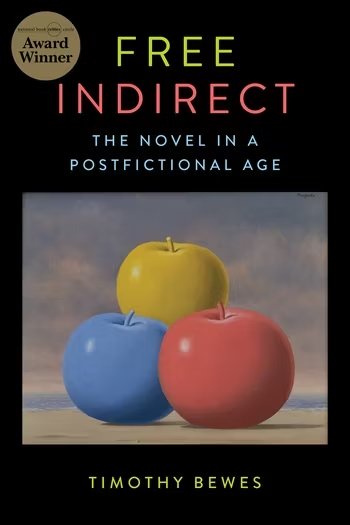While all men might be equal in death, all sponsors must all be thanked in appropriately sized font. The memorial courtyard now contains an eternal flame, a donation from AGL, Santos and East Australian Pipelines. The gas for the eternal flame is ‘generously’ provided by Origin Energy under a sponsorship agreement. The gas industry’s ‘sacrifice’ in funding a tiny fraction of the local cost of the Australian War Memorial receives far more prominence than the names of Australian who gave their lives for our country. Lest we forget our sponsors. … While the irony of sponsorship by the oil industry, a fuel over which so many wars were fought in the twentieth century, might be missed by some, surely no one could miss the irony of BAE Systems, Lockheed Martin, Thales and other weapons manufacturers sponsoring the Australian War Memorial.
That striking passage comes from Richard Denniss’ new book Dead Right: how neoliberalism ate itself and what comes next. For Denniss, the evolution of the Australian War Memorial into a giant billboard illustrates the logic of neoliberalism, something that, he says, ‘has wounded our national identity, bled our national confidence, caused paralysis in our parliaments and is eating away at the identity of those on the right of Australian politics’.
Certainly, Lockheed Martin’s involvement with an institution purportedly commemorating battlefield deaths represents a particular crass commercialism, an unapologetic assertion of corporate interests over human sensibilities. Yet does that make it neoliberal?
In The Communist Manifesto, Marx and Engels outline the historical role played by the bourgeoisie. It has, they say:
pitilessly torn asunder the motley feudal ties that bound man to his “natural superiors”, and has left remaining no other nexus between man and man than naked self-interest, than callous “cash payment”. It has drowned the most heavenly ecstasies of religious fervour, of chivalrous enthusiasm, of philistine sentimentalism, in the icy water of egotistical calculation. It has resolved personal worth into exchange value, and in place of the numberless indefeasible chartered freedoms, has set up that single, unconscionable freedom — Free Trade.
That passage, first published in 1848, perfectly describes the War Memorial’s relationship with the defence industry.
You can see, then, the difficulty. What, precisely, do we mean when we discuss neoliberalism? Are we simply using a polite euphemism for ‘capitalism’ or do we refer to a distinctive social order altogether? Is neoliberalism an idea or a politics or a cultural phenomenon or some combination of all of these?
Denniss suggests ‘neoliberalism’ can be used, fairly straightforwardly, as ‘a catch-all term for all things small government’ and for a ‘blind faith in market forces’. In her book On Fairness, the ACTU secretary Sally McManus adopts a similar approach. She offers a raft of synonyms for what she calls the ‘political orthodoxy’: free market ideology, economic rationalism, Reaganomics, Thatcherism, the Chicago School, market economics and, of course, neoliberalism.
That orthodoxy can blamed, McManus says, for the number of Australians in casual employment doubling since the 1980s, even as more and more people are classified as ‘non standard workers’ with scarcely any entitlements at all. The guy who delivers fast food on his bike can’t claim sick leave if he’s too ill to pedal; the CEO of Domino’s Pizza took home $36.84 million in 2017, a year in which the heads of the hundred richest companies received a median salary rise of 12.4 per cent.
Similarly, Denniss tells the story of Shirley Carter, a woman who died at the private Opal Raymond Terrace Gardens nursing homes in October 2016, just a day after maggots had been discovered in her mouth. The facility subsequently warned her daughter not to make a fuss ‘because you know how these kind of things can be blown out of proportion’.
In many instances, the private sector that neoliberals laud simply can’t provide adequate outcomes for public services since utilities often constitute so-called ‘natural monopolies’, in which meaningful competition becomes impossible without extraordinarily wasteful duplication. As a result,
the privatization and so-called deregulation of the electricity market in Australia led to the biggest rise in in electricity prices since WWII. Hundreds of millions of dollars are now spent advertising and promoting electricity every year. … All the costs of marketing this essential service, and all the profits extracted by all the competitors, are passed onto consumers in the form of higher prices.
In a wealthy country like Australia, Denniss insists, tragedies like the Carter case should not be understood as inevitable. If governments wanted a first-rate aged care system, there would be a first-rate aged care system. Buzzwords such as ‘efficiency’, ‘productivity’ and ‘growth’ simply normalise and naturalise choices made by politicians about the resources they allocate.
Australia isn’t poor, it is rich beyond the imagining of anyone living in the 1970s or 80s. But so much of that new wealth has been vacuumed up by a few, and so little of that new wealth has been paid in tax, that the public has been convinced that ours is a country struggling to pay its bills.
Yet while McManus identifies contemporary neoliberalism with the Liberals, Denniss sees them as exemplifying neoliberalism’s demise. That’s because where she understands neoliberalism as a political platform, he treats it as a philosophy – and a philosophy used to hoodwink the public.
He gives the example of the Westpac Rescue Helicopter Service. The publicity campaign for this crucial institution shows a chopper winching a drowning father and son from the water, with a voice explaining that the man being saved ‘doesn’t bank with Westpac’ – and then adding ‘but we’re with all Australians’. It’s a slogan that sounds simultaneously self-congratulatory and passive-aggressive, as if the corporation considered itself well within its rights to let moochers sink beneath the waves. Yet, despite the Westpac logo, the helicopter service actually runs overwhelmingly on taxpayers’ money.
For Denniss, the hypocrisy typifies a philosophy that talks of the market but relies on the state. As a result, he suggests, neoliberalism has been increasingly discredited by the behavior of its advocates and beneficiaries. He points, in particular, to the Abbott-era conservatives who, he says, ‘were willing to destroy much of the public’s faith in experts and institutions to protect their friends in the fossil-fuel industry from what were, in theory, neoliberal policy tools such as the carbon tax and the mining tax.’
Their cultural war interventions have exposed them as frauds, ‘now entirely incapable of using those same experts and institutions to persuade the public to take another large does of fiscal pain in the hope it will deliver long term gain.’ The neoliberal jig is up, we might say.
‘That key voices on the right locally,’ Denniss says, ‘are now devoting so much time to advocating the importance of Western culture and Australian values is proof that they have abandoned the fundamental neoliberal tenet that economic growth can solve all social and environmental problems. It was not that long ago that the right believed that the only values that mattered were market values.’
But there’s a problem with that argument – namely, that it’s demonstrably not true. The right never believed that only market values mattered, not even back when its key representatives espoused neoliberal principles less shamefacedly than they do today. Think of the Reaganism and Thatcherism invoked by McManus. Margaret Thatcher certainly championed the free market but she also lauded ‘Victorian values’, suggesting they where what prevailed ‘when our country became great’, while Ronald Reagan devoted as much effort to rolling back the culture of the sixties as to shrinking the size of the government.
In Australia, the War Memorial itself demonstrates the importance of non-market values to John Howard, a man also deeply committed to neoliberalism.
In the 1980s, Anzac Day was barely commemorated, with many veterans choosing not to attend the declining annual services. The resurgence of Anzackery in the mid-1990s emerged semi-organically from a revival of Australian militarism – but it also owed a great deal to the state-backed ideological campaign rolled out by Howard. As Howard pivoted away from the multicultural nationalism of the Hawke-Keating era (which he attacked using the imported concept of ‘political correctness’), he revived a more Anglophile jingoism rooted in military prowess, and he did so using the resources of the state.
As Marilyn Lake notes, once upon a time, the Department of Veteran’s Affairs did not conduct promotion at all, other than running modest programs to help families remember loved ones. Howard transformed it into propaganda machine. ‘The vast pedagogical enterprise of the DVA,’ says Lake, ‘which under its Commemorative Activities programme has supplied all schools in Australia, primary and secondary, with voluminous and sophisticated curriculum materials, websites, virtual tours of the battlefields, handsome prizes including trips to Gallipoli and other battlefields – has been made possible by massive funding from the federal government …’ The continuing expansion of the War Memorial was facilitated by that effort, funded by the state rather than the market.
Where Denniss might see that as further hypocrisy by the ideologues of ‘small government’, Elizabeth Humphrys, in a tremendously important new book, stresses that neoliberalism always depends on the state. Unlike the others, she does offer a definition. For Humphrys, neoliberalism can be understood as
a state-centred hegemonic political project remaking capitalist production and social reproduction since the end of the long boom. Neoliberalism is not simply a process of state-led economic transformation necessitated by economic crisis, nor is it merely an ideology or a set of ideas. Neoliberalism involves the development and implementation of a political project that utilises modified neoclassical economics to bring coherence to a suite of characteristic policies and economic changes—even if neoliberalism in theory varied from neoliberalism in practice.
The emphasis on a ‘political project’ signals a very different approach. For Humphrys, neoliberalism should not be understood solely in terms of particular political or even economic doctrine. It should be seen as a political practice, undertaken in response to an economic downturn, with the aim of restoring profitability and facilitating capital accumulation. To that end, it seeks to disorganise and defeat the organisations of the labour movement and increase the proportion of national income transferred from the working class to the capitalist class.
Denniss, by contrast, focuses on neoliberalism as a set of ideas – and then attributes those ideas a curious power, one almost independent of human agency. Neoliberalism, he says, ‘has made us more selfish and less trusting’. It has ‘changed our culture’; it has ‘trained us’; it has ‘radically altered the way we see the role of government’.
But, of course, ‘neoliberalism’ has done none of those things. Particular people have – and they’ve done them in certain ways in specific historical contexts. As Humphrys puts it, ‘neoliberalism as-ideology does not become neoliberalism-as-phase-of-capitalism until this ideology is made manifest in a political project, implemented by political society through the state.’ That’s the key to How Labour built Neoliberalism.
Humphry’s title, in and of itself, will strike many as a provocation – or even a flat out nonsense. We’re accustomed to identify neoliberalism with a history that unfolded in Britain and the US (and perhaps Chile). In those places, neoliberalism meant something done to – and not by – labour, implemented by rightwing parties in a war against unions.
But Humphrys rejects the methodology that distills Thatcher, Reagan and Pinochet into a generic template against which other neoliberals can be measured. It’s an approach, she says, that ignores the quite different dynamic that took place elsewhere, including in Australia and New Zealand.
In this country, it was in the period in which the unions participated in Labor’s Prices and Incomes Accord that most of ‘reforms’ usually identified with neoliberalism were implemented. The float of the Australian dollar and the abolition of exchange controls; significant privatization of state-owned assets; the promotion of free trade at the expense of tariffs; the deregulation of the financial and banking sectors; the introduction of corporatization within government departments; the construction of user-pays mechanisms: these and other measures were introduced by the ALP, not the conservatives.
Humphrys’ sense of neoliberalism as a project drives her to historicise. She identifies four different stages of its implementation: a proto-neoliberal phase between 1973 and 1983; a vanguard phase between 1983 and 1993; a piecemeal stage between 1993 and 2008; and a crisis stage after 2008.
The suggestion that the final years of the Whitlam government could be described as ‘proto-neoliberal’ might shock readers. But Humphrys argues that, by 1975, with Labor struggling with an intractable economic crisis, Whitlam was arguing for tariff reduction, the necessity of private sector profitability and other ideas later associated with neoliberalism.
The Dismissal meant such tendencies remained embryonic. It also, Humphrys says, prevented Malcolm Fraser from developing his own neoliberal project, since his involvement with the sacking of Whitlam left him bereft of necessary political capital. Whatever his intentions, he simply wasn’t capable of disciplining unions, forcing down wages or implementing wider economic reforms.
As a result, Fraser – an open admirer of Thatcher, and widely seen as a man of the hard right – actually ‘stood against the drive within the Liberal Party to implement a generalised neoliberal policy framework – even in a context of a state bureaucracy increasingly influenced by and committed to such policies.’
Even more surprisingly, Humphrys contends that the election of John Howard, an avowed advocate of the free market, marked, not the intensification of neoliberalism, but the point at which it began to falter, with Howard unable to deliver the radical reforms that his supporters wanted. She cites no less an authority than Paul Kelly. ‘It is tempting,’ Kelly says, ‘for Labor to depict the demise of Australian neoliberalism in 2007 with Howard’s fall but the only tenable location for such an event is the 1993 poll.’
That poll, of course, was the one in which John Hewson ran on the neoliberal Fightback! platform – and suffered a surprise defeat. Hewson’s loss – and, later, the rise of One Nation – demonstrated the deep unpopularity of neoliberalism, something that made Howard cautious about pursuing further reforms.
Crucially, Paul Keating won in 1993 only by making a sharp ideological jag, rejecting the market orientation he and Hawke had championed for a decade. As Humphrys says: ‘Keating [ran] against his own neoliberal record and oriented the election campaign on a more traditional social democratic agenda around job creation and tax cuts for workers.’
That, perhaps, helped establish the sense by many on the left that Hawke/Keating ‘economic rationalism’ constituted a progressive – or, at least, less reactionary – alternative to neoliberalism proper. For instance, while McManus describes Paul Keating as ‘lead[ing] the most radical remaking of the Australian economy into a neoliberal framework’, she also claims that the government in which he played such an important role
moderated the [American] version of neoliberalism, by retaining investment in expansive social programs, infrastructure and services, and worked with unions to extend and deliver positive initiatives like Medicare and compulsory superannuation. At the same time, it privatised formerly government-owned assets like the Commonwealth Bank and Qantas. Keating is remembered as a “staunch defender of open markets” by publications like The Age, but he’s watched what neoliberalism’s wreaked in the last thirty years, and come to question its core assumptions. “We have a comatose world economy held together by debt and central bank money,” he said in March 2017. “Liberal economics has run into a dead end and has no answer to the contemporary malaise.”
But this simply won’t wash.
As Humphrys shows, Keating was not averse to rhetorical attacks on the economists of the right. But in 1984, with the Hawke/Keating project getting underway, Euromoney Magazine named Keating ‘Finance Minister of the Year’, not because he stood outside the free market orthodoxy of the time but because he so thoroughly exemplified it. As Keating explained in 2007, his role during the Accord years was to be ‘the guy who had to get the ACTU in a headlock and pull its teeth out with a pair of pliers’.
That’s Humphry’s key point. In the Australian context, Keating wielded the pliers because the Liberals simply weren’t capable of implementing a neoliberal agenda. It took Labor to make neoliberalism because, in the specific circumstances, no other social force possessed sufficient authority.
In 1983, Bob Hawke won a landslide victory presenting himself as the candidate capable, because of his background in the ACTU, of preventing industrial turmoil. That was the basis on which the new Labor government entered into a formal social contract with the trade unions. Hawke, Keating, and other Labor ministers believed Keynesianism had been discredited in the turmoil of Whitlam’s last years and, in an era of falling profitability, accepted the pro-market consensus that was emerging globally. How, though, to implement free market policies, given the organisation and combativity of the unions?
In those circumstances, the Accord provided an ideal mechanism for engendering working class consent, via a new form of corporatism that built upon existing corporatist traditions (such as the longstanding acceptance of arbitration) within the Australian labour movement. The unionists who signed the Accord did not do so because they were secret Hayekians. On the contrary, in another historical perversity, many of figures most committed to the process belonged to the Communist Party. The CPA’s Laurie Carmichael even argued at the 1985 ACTU congress that the Accord represented ‘a transitional program for socialism’.
Yet, if you understand neoliberalism as a project rather than a pure philosophy, it’s less surprising to discover its architects deploying whatever ideas came to hand. The particular form that neoliberalism took depended on context. Just as Thatcher made use of ‘Victorian values’ to promote a free market that undermined those values, Hawke used ‘economic planning’ to win support for privatisation.
Humphrys shows that the Accord significantly curtailed working class wages as a whole, while fostering a growing inequality between wages of the highest and lowest paid. For the most part, it did not deliver the social wage promised as compensation. Humphrys says the establishment of Medicare – the most commonly cited union achievement of the period – should be understood as ‘the clawing back of past gains that had been lost [since it restored the Medibank system abolished by Fraser], although at a greater cost to workers than before as they were required to accept a reduction in take-home pay’.
As for the introduction of compulsory superannuation, this was, she said, a policy in line with ‘the global trend in the neoliberal period […] to shift risk for retirement on to individuals and decrease government responsibility. Meanwhile, the ACTU’s pledge to maintain wage discipline and industrial peace brought disastrous consequences to the union movement as a whole.
In her book, McManus recalls the importance to her generation of unionists of the strikes that took place as ‘neoliberalism [was] hitting our shores’. She discusses, in particular, the disputes at the Mudginberri abbatoir and the Dollar Sweets company, both of which were associated with the New Right and Liberal Party.
She doesn’t acknowledge that, because of the ACTU’s commitment to the Accord, it provided, as Humphrys, very little support for the union being sued over Mudginberri, nor that ‘the ACTU disciplined [the Federated Confectioners’ Association for campaigning against Dollar Sweets] by publicly condemning its action as outside the Accord and withheld all practical support for the union’.
Neither does she mention that the ACTU supported Labor as it deregistered the militant Builders Labourers Federation and crushed the pilots’ dispute. In respect of the latter, Bob Hawke deployed the military as strike breakers, arguing that:
… the pilots had no right to demand a 30 percent wage increase outside the arbitration system while the rest of the workforce, within it, accepted lower wage increases in the national interest[—and that] giving in to the pilots would spur other militant unions to a wages blow-out that would destroy the economy.
The passage exemplifies Hawke’s ability to neutralize the union movement in pursuit of a market agenda in a way that Fraser – or, indeed, Howard – simply could not. Had a Liberal government used military power to crush a wage claim and set an example to ‘other militant unions’, an appalled labour movement would have fought back. Hawke, however, could break the pilots, precisely because he could count on the ACTU’s support.
It’s an illustration of how the Accord helped ‘build neoliberalism’, teaching a cadre of well-respected union officials to argue for – or, at least, defend – free market policies within the very heart of the labour movement.
As Hawke and Keating embraced deregulation and free trade, their positions were justified inside the unions by militants, who used their reputations to sell Labor’s new approach. Humphrys thus describes the Accord as ‘highly successful in disorganizing labour and in preventing the labour movement from exercising its own social weight – a social weight that had earlier required the Accord to be established’.
Because the agreement with Labor emphasized consensus rather than struggle, and promised gains based on official negotiation rather than rank-and-file action, it rendered the democratic structures fostered by the militancy of the seventies increasingly irrelevant and so helped erode union density. Thus, in another fundamental paradox, the Accord itself destroyed the conditions under which it emerged, weakening the union power that had made the distinctly Australian version of neoliberalism possible.
In 1983, Hawke’s National Economic Summit gave the trade unions a prime seat at the table, a reflection of the power they possessed. When Kevin Rudd won in 2007, his 2020 Forum consciously echoed Hawke’s event – except that, with the social weight of the unions significantly reduced, most of the participants to Rudd’s event attended as individual celebrities.
By Humphrys’ own argument, the Accord will not be repeated any time soon. The unions no longer pose the same threat; the ACTU does not exert the influence it once did on the working class as a whole. Why, then, should anyone, other than historical specialists, care about precisely what happened back in the 1980s? Put simply, the Accord still matters because we are living in the society that it made.
In Dead Right, Denniss agrees with Humphrys that the era of neoliberal predominance has come to an end. Its consequences, however, continue to play out, through widespread social misery but also in the form of political dysfunction. ‘Neoliberalism is dead,’ he writes, ‘but its tired and narrow vision has nearly crushed the life out of our democracy.’
He suggests the Liberals face a particular problem as they struggle to justify their policy choices in a context in which neoliberal arguments no longer possess much rhetorical power. ‘[N]ow that our prime minister and his party are proudly out the neoliberal box…’ he writes, ‘they need to find another explanation for choosing to subsidise coalmines but not dental care, and for why the nation can afford to spend $65 billion on tax cuts but no on better pay for child- and aged-care workers.’
By contrast, the same situation presents an opportunity for Labor, a party that has ‘handled the pivot away from free-market fundamentalism much better than the coalition’.
In the wake of the Global Financial Crisis, Denniss says, ‘[t]he ALP has hit on the winning policy and political strategy of closing the tax loopholes that deliver so much money to the top ten per cent on income earners while gaining so many votes from the other 90 per cent. There are even plenty of cashed up retirees who are happy to vote to close the loopholes their accountants have shown them, if only because they see how impossible it will be for their kids or their grandkids to thrive in such an inequitable system.’
At this point, the astute reader will realise that Dead Right dates from shortly before the most recent poll, back when the smart money expected that, as Denniss puts it, the ‘the 2019 federal election [would be] where all these chickens come home to roost’.
There’s no shame in miscalling a vote – lots of us got the 2019 result wrong. Yet Denniss’ confidence in Liberal disarray reflects more than a misassessment of Scomo’s personal likability.
He writes well and at length about the simmering rage created by the neoliberal experiment. ‘After decades of distributional warfare,’ he says, ‘the gap between the winners and losers has grown too wide to explain away. No-one believes that the wealth will soon trickle down. No one believes regional Australia is about to catch up with the capital cities. And no one believes a word that the business leaders, politicians and senior public servants who spent decades selling neoliberalism have to say.’
Yet labour’s role in the establishment of neoliberalism in Australia marked both the union movement and the ALP, leaving both of them shells of their former selves.
In the 2019 election, Bill Shorten might have spoken out against social inequality in a way that the Liberals simply couldn’t. But Labor – and, for that matter, labour – now lacks the social base on which reformist policies once depended.
In the past, the ALP could rely upon an activist membership that would take its program into workplaces and neighbourhoods, thus giving the organisation a certain institutional stability. That no longer exists. As a result, Shorten struggled to sell his platform – and, as soon as he lost the election, Labor collapsed back into precisely the kind of ideological turmoil that Denniss correctly diagnosed in the Liberals.
But if the history of Accord matters for understanding the Labor Party, it matters even more for grasping the state of the union movement. McManus opens On Fairness with a discussion of her first ABC 7.30 appearance, an interview in which she defended the right of workers to take industrial action, despite Australia’s extraordinarily punitive legal environment. ‘[I] believe in the rule of law where the law is fair,’ she told Leigh Sales, ‘when the law is right. But when it’s unjust, I don’t think there’s a problem with breaking it.’
It was a moment that electrified many unionists – the first time in recent history that an ACTU leader had spoken so openly about the need for workers to pursue their interests, irrespective of the legal consequences. Immediately afterwards, McManus attended a Teachers Federation meeting and received a standing ovation from the other unionists. Predictably, she was slated by politicians and rightwing commentators, with Malcolm Turnbull denouncing ‘this flagrant disregard for the rule of law by unions.’
In her book, McManus is satisfyingly scathing about Turnbull and his ilk, noting that ‘[f]rom the origins of modern trade unions during the Industrial Revolution, to the Australia of today, workers have always confronted a threat of state-sanctioned punishment when they’ve decided to take action in their own industrial interests.’
Yet she simply doesn’t mention that Bill Shorten, the then leader of the Labor Party, joined with Turnbull in condemning her. It’s symptomatic of a determination, throughout the book, to present the struggle for ‘fairness’ as a battle against a neoliberalism embodied almost exclusively in the Liberal Party.
The unwillingness to recognise Labor’s role in union decline or social stratification isn’t merely a theoretical problem but an issue with immediate and practical consequences. Most obviously, in an election year, the ACTU’s ‘Change the Rules’ mobilisation against the Australian industrial relations regime quickly devolved into an effort focused almost exclusively on electing a Labor government – essentially, a reprise of the WorkChoices campaign that had helped Kevin Rudd defeat John Howard.
There was almost no acknowledgement of what Rudd’s victory had meant for unions: that rather than abolishing all the obstacles in the way of organizing, Rudd – and then Gillard – had constructed what became the Fair Work Commission, the body in charge of the rules that, in 2019, unions sought to change.
In any case, Shorten went on to lose the election, leaving the unions with almost nothing to show from all the ‘Change the Rules’ agitation.
In the aftermath of Morrison’s unlikely victory, the parlous state of the Australian left needs to be openly and honestly acknowledged. With the catastrophic breakdown of the natural world, international capitalism is entering into a new and dangerous era of crisis – one that the evolution of radical thought has left progressives particularly ill-prepared to address.
Thus, when Bob Hawke died shortly before the 2019 election, much of the liberal commentary contrasted favourably the ambition of his reform agenda with the paralysis of politicians today, as if there were no relationship between the policies of the Hawke-Keating years and today’s era of dysfunction and decline.
Yet, in all sorts of ways, the society we inhabit is the society that Labor created back in that crucial period. That’s why Humphrys’ book, in particular, matters so much.
It’s an academic text and thus not an easy read, particularly since it bears the scars of a postgraduate origin. Ideally, Humphrys might be persuaded to write a follow-up for a popular audience, so as bring the material to a broader readership. In the meantime, find yourself a copy of How Labour Built Neoliberalism. Plenty of people won’t agree with Humphrys’ thesis. But she makes a serious, well-researched and persuasive case, which challenges a great deal that’s been written about the recent past. If you’re at all concerned about the state of the Australian left, you need to engage with her work.
